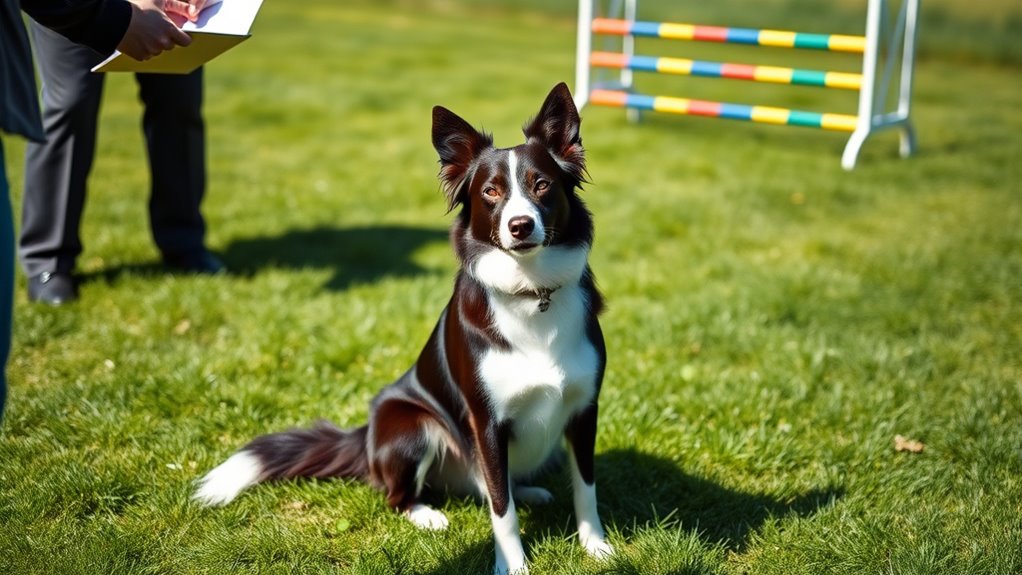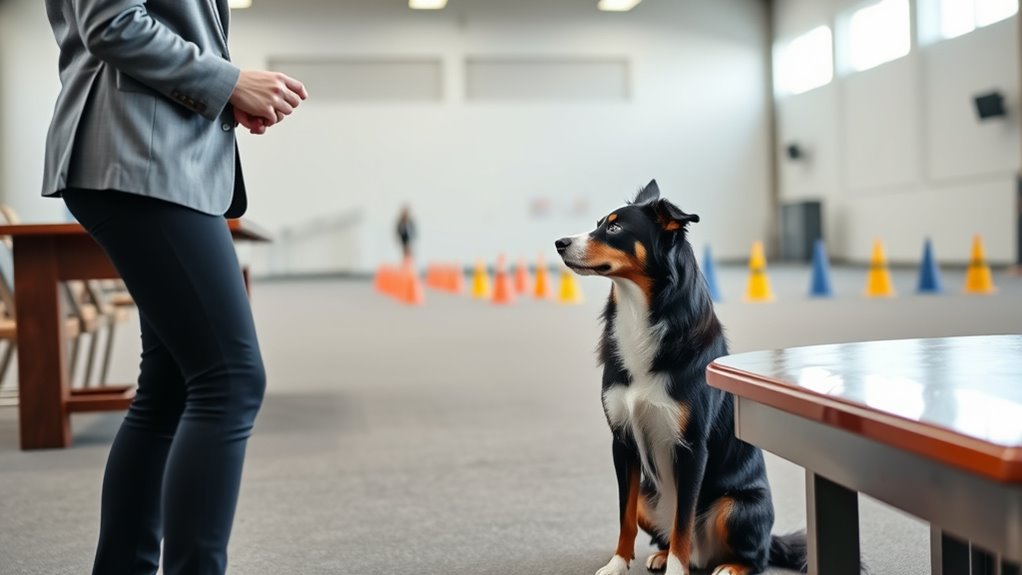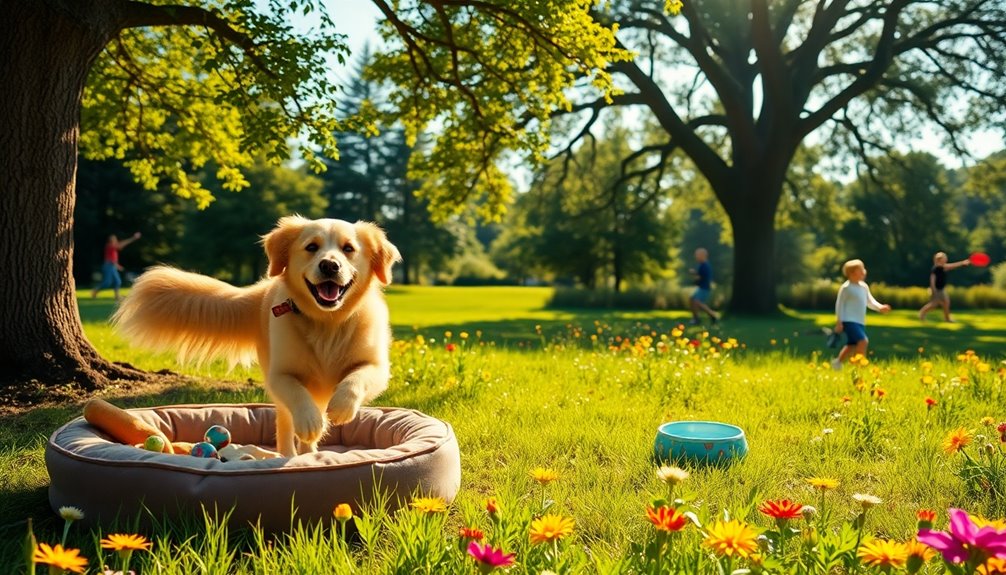In obedience trials, you can expect your dog to perform a series of commands like heel, sit, stay, and recall, often under distractions and time pressure. To prepare, focus on consistent training using positive reinforcement and practice in varied environments to build reliability. Work on building your dog’s confidence and focus, especially in simulated trial scenarios, to handle external stimuli. Keep a patient, positive attitude and stay committed—there’s much more to mastering these competitions as you’ll discover if you continue exploring.
Key Takeaways
- Understand the specific rules and exercises required for your obedience trial level.
- Consistently practice commands in various environments to simulate competition conditions.
- Use positive reinforcement to build reliability and confidence in your dog’s responses.
- Focus on clear communication, timing, and handling techniques to ensure precise performance.
- Maintain patience and a positive attitude, gradually increasing difficulty and distractions during training.

Have you ever wondered what it takes to train a dog to perform precise commands reliably? Preparing for obedience trials requires a solid understanding of training techniques and a good grasp of dog psychology. These elements work together to help your dog understand what’s expected and build the confidence needed to succeed. The training techniques you choose should focus on consistency, patience, and clear communication. Positive reinforcement is key—you want your dog to associate commands with rewards, making learning enjoyable rather than stressful. Using treats, praise, or play as incentives encourages your dog to repeat desired behaviors. Break down complex commands into manageable steps, practicing each until your dog masters it before moving on. This methodical approach helps prevent confusion and builds a strong foundation for more advanced skills. Incorporating timing and pacing into your training ensures that your dog understands the connection between commands and rewards, which is crucial for reliable performance.
Consistent, patient training with positive reinforcement builds a confident, well-behaved dog ready for obedience trials.
Understanding dog psychology is equally important. Dogs learn through association and experience, so recognizing how your dog perceives commands and environment can influence your training effectiveness. For example, some dogs respond better to visual cues, while others rely more on verbal commands or body language. Being aware of your dog’s individual temperament and learning style allows you to tailor your training techniques accordingly. Consistent cues, clear boundaries, and patient repetition help your dog internalize commands more quickly. Keep training sessions short and frequent to maintain your dog’s interest and prevent frustration. Over time, your dog will start to anticipate commands and respond promptly, which is essential during obedience trials.
As you prepare, consider incorporating mental stimulation and confidence-building exercises. These activities improve focus and reduce anxiety in high-pressure situations like competitions. Simulate trial conditions during practice—practice in different environments, with distractions, and under time constraints. This prepares your dog to perform reliably regardless of external stimuli. Remember, the goal isn’t just to teach commands but to develop a trusting, communicative relationship. When your dog understands that obeying commands leads to positive outcomes, they’ll be more motivated and engaged during the actual trial.
Finally, stay patient and keep a positive attitude. Training is a journey, not a quick fix. Celebrate small victories along the way, and don’t get discouraged if progress feels slow at times. Consistent application of training techniques rooted in dog psychology will ultimately lead to success. With dedication, patience, and a clear plan, you’ll help your dog perform confidently and reliably during obedience trials, showcasing their skills and strengthening your bond at the same time.
Frequently Asked Questions
How Can I Tell if My Dog Is Ready for Obedience Trials?
You can tell if your dog is ready for obedience trials by observing training readiness and behavioral indicators. If your dog consistently responds well to commands, remains focused, and follows cues calmly in various environments, they’re likely prepared. Additionally, if your dog shows confidence and enthusiastic to please, it’s a good sign. Keep practicing regularly, and consult your trainer to guarantee your dog’s behavioral indicators align with trial requirements.
What Should I Bring on the Day of the Trial?
Imagine you’re heading to your first obedience trial, and you realize you forgot essential items. Bring grooming supplies to keep your dog looking sharp and a properly fitted leash to demonstrate good leash techniques. Pack water, treats, your dog’s registration, and a clean towel for grooming touch-ups. These essentials guarantee your dog stays comfortable, confident, and ready to perform at their best during the trial.
How Are Obedience Trial Scores Calculated?
You score obedience trials based on the judging criteria, which include precision, timing, and teamwork. The judge evaluation focuses on how well your dog performs each exercise, honoring commands promptly and accurately. Points are deducted for mistakes like hesitations or incorrect responses. Your overall score reflects your dog’s obedience and your handling. Keep practicing to improve your performance, and remember, consistent effort often leads to higher scores.
What Are Common Mistakes to Avoid During the Trial?
During the trial, avoid training mistakes like inconsistent commands or unclear signals, which can lead to miscommunication pitfalls. Stay calm and focused, making sure your dog understands each cue perfectly. Don’t rush commands or get distracted, as that can impact your score. Keep your training consistent leading up to the event, and always reward good behavior. Being prepared and clear helps you and your dog perform confidently, minimizing errors.
Are There Age Restrictions for Participating in Obedience Trials?
Yes, there are age restrictions for obedience trials. Typically, puppies are eligible once they’ve reached a specific age, often around six months, but check the event’s rules for puppy eligibility. You’ll need to go through age verification procedures to confirm your dog’s age. Make sure your puppy is old enough and properly verified before entering, so you avoid disqualification or complications on the day of the trial.
Conclusion
As you step into the arena, remember that obedience trials are like a mirror reflecting your bond with your dog. Each command is a brushstroke on a shared canvas, shaping trust and understanding. With patience and practice, you’ll reveal a masterpiece of teamwork. Trust the journey, knowing that every sit, stay, and recall is a symbol of your dedication. Embrace the challenge, and watch your partnership bloom like a vibrant garden, full of promise and growth.










